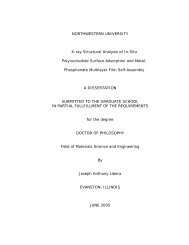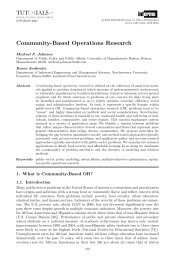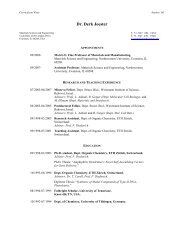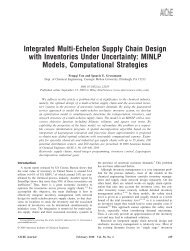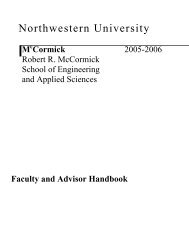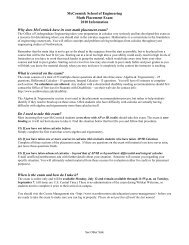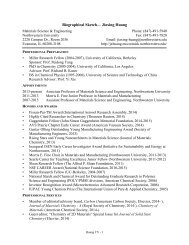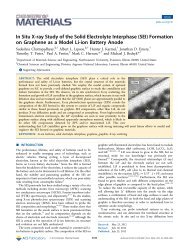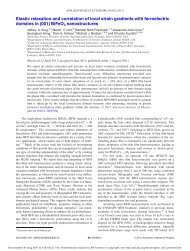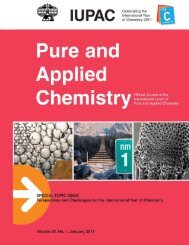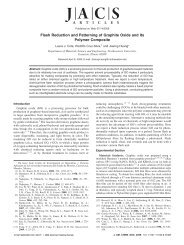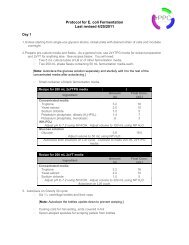Graphene Oxide Nanocolloids - Jiaxing Huang Group Homepage
Graphene Oxide Nanocolloids - Jiaxing Huang Group Homepage
Graphene Oxide Nanocolloids - Jiaxing Huang Group Homepage
Create successful ePaper yourself
Turn your PDF publications into a flip-book with our unique Google optimized e-Paper software.
Published on Web 11/24/2010<br />
<strong>Graphene</strong> <strong>Oxide</strong> <strong>Nanocolloids</strong><br />
Jiayan Luo, Laura J. Cote, Vincent C. Tung, Alvin T. L. Tan, Philip E. Goins, Jinsong Wu, and<br />
<strong>Jiaxing</strong> <strong>Huang</strong>*<br />
Department of Materials Science and Engineering, Northwestern UniVersity, EVanston, Illinois 60208, United States<br />
Received September 2, 2010; E-mail: jiaxing-huang@northwestern.edu<br />
Abstract: <strong>Graphene</strong> oxide (GO) nanocolloidsssheets with lateral<br />
dimension smaller than 100 nmswere synthesized by chemical<br />
exfoliation of graphite nanofibers, in which the graphene planes<br />
are coin-stacked along the length of the nanofibers. Since the<br />
upper size limit is predetermined by the diameter of the nanofiber<br />
precursor, the size distribution of the GO nanosheets is much<br />
more uniform than that of common GO synthesized from graphite<br />
powders. The size can be further tuned by the oxidation time.<br />
Compared to the micrometer-sized, regular GO sheets, nano GO<br />
has very similar spectroscopic characteristics and chemical<br />
properties but very different solution properties, such as surface<br />
activity and colloidal stability. Due to higher charge density<br />
originating from their higher edge-to-area ratios, aqueous GO<br />
nanocolloids are significantly more stable. Dispersions of GO<br />
nanocolloids can sustain high-speed centrifugation and remain<br />
stable even after chemical reduction, which would result in<br />
aggregates for regular GO. Therefore, nano GO can act as a<br />
better dispersing agent for insoluble materials (e.g., carbon<br />
nanotubes) in water, creating a more stable colloidal dispersion.<br />
<strong>Graphene</strong> oxide (GO) is typically made by chemical exfoliation<br />
of graphite powders using strong oxidants such as KMnO 4 dissolved<br />
in concentrated H 2 SO 4 . 1-4 During reaction and processing, the<br />
graphene sheets in the particles are not only derivatized with<br />
oxygen-containing groups 5,6 but also torn up into smaller pieces.<br />
As a result, the lateral sizes of the as-synthesized GO sheets are<br />
usually very polydisperse, ranging from a few nanometers to tens<br />
of micrometers, 7,8 which may even vary from synthesis to synthesis.<br />
Although it has been noted that prolonged oxidation 9 and sonication<br />
10 can break the sheets into smaller sizes, such random, topdown,<br />
size reduction approaches are unlikely to result in uniform<br />
size distribution. So far, size-controlled synthesis 9 of small GO sheets<br />
has not been extensively studied, partially due to the lack of interest<br />
and knowledge on their size-dependent properties. Although a tremendous<br />
amount of work has been done to explore the size- and shapedependent<br />
electronic properties of graphene nanostructures, 11-14 nano<br />
GO and its graphene product have caught much less interest,<br />
presumably due to the highly defective nature of GO. Recently we<br />
revealed that GO sheets can act as surfactants with size-dependent<br />
amphiphilicity. 15 Smaller GO sheets should be more hydrophilic due<br />
to the higher density of charges originating from the ionized -COOH<br />
groups on their edges, which suggests that the colloidal stability of<br />
GO should also be size-dependent. This motivates us to explore direct<br />
synthetic methods for making small GO sheets with a more uniform<br />
size distribution. On the other hand, GO nanosheets (
COMMUNICATIONS<br />
Figure 2. (a) UV/vis and (b) XPS spectra of nano GO before (brown line)<br />
and after hydrazine reduction (black line). (c) Thermogravimetric analysis<br />
curve of the nano GO, exhibiting weight loss similar to that observed with<br />
regular GO.<br />
the diameter of the nanofibers, GO nanosheets are more uniform<br />
than regular GO. After 2hofreaction, the average size of GO was<br />
found to be around 50 nm (Figure 1c), which decreased to ca. 20<br />
nm after 12 h of reaction (Figure 1c, inset and d). The apparent<br />
thickness of the GO nanosheets was measured to be around 1 nm<br />
by atomic force microscopy (AFM), which is consistent with that<br />
of regular GO. 25,26 Since the diameter of the graphite nanofibers<br />
can be controlled from a few to a few hundreds of nanometers<br />
during chemical vapor deposition, 22,23 by selecting the properly<br />
sized graphite nanofibers and controlling the oxidation time, the<br />
size of GO nanosheets should be continuously tunable in this range.<br />
The UV/vis spectrum of the nano GO dispersion (Figure 2a)<br />
shows a peak at 225 nm, slightly blue-shifted compared to that of<br />
regular GO at 230 nm, indicating a modest decrease in the size of<br />
the π conjugation domains. The nano GO can be reduced by<br />
hydrazine, after which its absorption peak was red-shifted and the<br />
overall absorption was greatly increased. This is consistent with<br />
the color change of the colloidal dispersion from brown to black,<br />
similar to what has been observed with regular GO. 27 X-ray<br />
photoelectron spectroscopy (XPS) confirmed that hydrazine reduction<br />
significantly reduced the oxygen content in the sample (Figure<br />
2b). The nano GO can also be reduced by thermal treatment. Figure<br />
2c shows its thermal gravimetric response upon heating in a N 2<br />
atmosphere. A nearly 10% weight loss occurred at about 100 °C,<br />
which can be attributed to absorbed water. Another major weight<br />
loss of nearly 40% was observed between 200 and 300 °C,<br />
corresponding to the deoxygenating reactions as observed in regular<br />
GO. 28 The results in Figure 2 suggest that, in terms of spectroscopic<br />
characteristics and chemical properties, these GO nanosheets are<br />
very similar to regular micrometer-sized GO. 4,7,8<br />
However, size is very important for the surface activity of GO.<br />
Regular micrometer-sized GO colloids tend to migrate to the water<br />
surface over time, 15,29-31 as shown in the Brewster angle microscopy<br />
(BAM) image (Figure 3a). This eventually leads to a GO thin<br />
film covering the surface of an evaporating droplet, which leaves<br />
a continuous film after drying (Figure 3c, left and d). In contrast,<br />
the GO nanosheets preferably stay in water (Figure 3b). A droplet<br />
of GO nanocolloids tends to leave the typical “coffee ring<br />
stain” 32,33 type of drying pattern, just like common water-soluble<br />
or dispersible materials (Figure 3c, right and e). The different drying<br />
behaviors between regular and nano GO colloids were consistently<br />
observed over a wide range of concentrations from 0.01 to 1 mg/<br />
mL (Supporting Information (SI) Figure S1). Since evaporation is<br />
a fundamental step in all solution-processing techniques, the<br />
knowledge of size-dependent drying behaviors should be useful<br />
for the fabrication of GO-based thin films and coatings.<br />
The decreased surface activity of GO nanosheets is likely due<br />
to their higher edge-to-area ratio, which increases their charge<br />
density and makes them more hydrophilic. This has been confirmed<br />
by zeta-potential measurements, as shown in Figure 4a. The higher<br />
charge density on GO nanosheets also significantly increases their<br />
colloidal stability. GO nanocolloids remained stable even after<br />
Figure 3. Surface activity of regular and nano GO. (a,b) In situ BAM<br />
observation of air-water interface during evaporating a GO and GO<br />
nanocolloidal solutions, respectively. Regular GO sheets tend to enrich at<br />
the water surface over time, but nano GO is much less surface active.<br />
Therefore, regular GO colloids tend to develop a coating on the water surface<br />
during evaporation and leave a continuous film after drying (c,d). In contrast,<br />
GO nanocolloids tend to leave the typical “coffee ring stain” type of drying<br />
marks commonly seen for aqueous colloidal dispersions (c,e). The scale<br />
bars in panel c represent 1 cm.<br />
Figure 4. Enhanced colloidal stability of nano GO and nano r-GO. (a)<br />
Zeta-potential measurement of water dispersion of GO, nano GO, and nano<br />
r-GO. Values of r-GO sheets could not be measured due to heavy<br />
aggregation (b). GO nanocolloids appear to have higher charge density,<br />
which is consistent with their greatly reduced size and increased edge-tocenter<br />
ratio. Therefore, they are much more stable than regular GO (see<br />
Figure S2). In contrast to regular r-GO (b), the r-GO nanocolloids (c) are<br />
also much more stable, resulting in stable colloidal dispersion over a wide<br />
range of solution pH values.<br />
centrifugation at 10 000 rpm for 30 min, while the regular GO<br />
colloids started to precipitate at 5000 rpm (SI Figure S2). It has<br />
been well known that r-GO colloids are less stable in water due to<br />
increased π-π stacking between the deoxygenated surfaces. 27 As<br />
seen in Figure 4d, hydrazine-reduced r-GO sheets indeed aggregated<br />
under most of the pH values from 4 to 10, thus preventing zetapotential<br />
measurements. However, r-GO nanosheets were found to<br />
be stable in the entire range of pH values (Figure 4c). With GO or<br />
r-GO sheets, their colloidal stability is determined by the competition<br />
between repulsive electrostatic interaction and attractive, faceto-face<br />
van der Waals interaction of overlapping sheets. 25,34 The<br />
enhanced colloidal stability of nano GO and r-GO is attributed to<br />
a combination of increased electrostatic repulsion, reduced overlapping<br />
areas, and reduced probability of overlapping due to smaller<br />
areas of the nanosheets.<br />
The enhanced colloidal stability of GO nanosheets should make<br />
them excellent dispersing agents for processing insoluble materials.<br />
In an earlier report, we showed that GO can act as a surfactant to<br />
disperse graphite powders and carbon nanotubes in water. 31 Here,<br />
the performances of regular GO and nano GO as dispersing agents<br />
for unfunctionalized single-walled nanotubes (SWCNTs) (Carbon<br />
17668 J. AM. CHEM. SOC. 9 VOL. 132, NO. 50, 2010
COMMUNICATIONS<br />
support was provided by the Initiative for Sustainability and Energy<br />
at Northwestern (ISEN) (V.C.T, A.T.L.T., and P.E.G.), a seed grant<br />
from the Northwestern Nanoscale Science and Engineering Center<br />
(NSF EEC 0647560) (J.L), and the Sony Corp. L.J.C. is a NSF<br />
graduate research fellow. A.T.L.T. thanks the Defence Science and<br />
Technology Agency of Singapore for an overseas undergraduate<br />
scholarship. We thank the Northwestern Materials Research Science<br />
and Engineering Center (NSF DMR-0520513) for a capital equipment<br />
fund for the purchase of BAM. Microscopy and surface<br />
analysis were carried out at the NUANCE center at Northwestern<br />
University.<br />
Supporting Information Available: Experimental details and other<br />
supplementary data. This materials is available free of charge via<br />
Internet at http://pubs.acs.org.<br />
Figure 5. Nano GO as a dispersing agent. (a) Both GO and nano GO can<br />
disperse unfunctionalized SWCNTs in water after sonication, but the<br />
resulting colloidal dispersion using nano GO is much more stable, as seen<br />
in the centrifugation test. (b,c) AFM images show that the SWCNTs were<br />
disentangled and debundled after being sonicated in nano GO dispersion.<br />
The average height of SWCNTs decreases from ∼20 nm in water to ∼4<br />
nm after dispersion (inset).<br />
Solutions, Inc., P2-SWNT) were compared. Figure 5a shows the<br />
dispersions of 1 mg of SWCNTs after being sonicated for 2hin2<br />
mL of nano GO, regular GO (both 1 mg/mL), and deionized water,<br />
respectively. The SWCNTs precipitated right after sonication. Both<br />
of the GO samples were able to disperse the nanotubes. However,<br />
the dispersion created using nano GO as surfactant was significantly<br />
more stable, as shown by the centrifugation test. The UV/vis<br />
spectrum (SI Figure S3) of the nano GO/SWCNTs dispersion shows<br />
the characteristic peaks of SWCNTs at 750 nm and nano GO at<br />
230 nm, both red-shifted, suggesting a strong π-π interaction<br />
between them. The AFM image of the starting SWCNTs show that<br />
the tubes were heavily entangled and bundled. The average bundle<br />
diameter measured by the height profile was ∼20 nm (Figure 5c).<br />
In contrast, nano GO dispersed SWCNTs were largely disentangled<br />
and debundled, with average diameter reduced to ∼4 nm (Figure<br />
5b). AFM studies found that the nanotubes are only partially<br />
covered by GO nanosheets (SI Figure S4). Therefore, the nano GO/<br />
SWCNT complex is still conductive, and the conductivity can be<br />
further increased by reducing the nano GO after solution processing<br />
(SI Figure S5).<br />
In summary, uniform GO nanocolloids can be directly synthesized<br />
using crystalline graphite nanofibers as the starting material.<br />
The diameter of the nano GO is determined by the nanofiber<br />
diameter and the oxidation time. GO nanosheets were found to be<br />
more hydrophilic than their regular, micrometer-sized counterparts,<br />
resulting in very different drying behaviors. The small size of nano<br />
GO also greatly enhances their colloidal stability. Even nano r-GO<br />
sheets are stable in a wide range of pH values. The enhanced<br />
stability of GO nanocolloids should make them very promising<br />
dispersing agents for insoluble, aromatic materials such as SWCNTs.<br />
Acknowledgment. This work was primarily supported by the<br />
National Science Foundation (CAREER DMR 0955612). Additional<br />
References<br />
(1) Brodie, B. C. Philos. Trans. R. Soc. London 1859, 149, 249–259.<br />
(2) Hummers, W. S.; Offeman, R. E. J. Am. Chem. Soc. 1958, 80, 1339–1339.<br />
(3) Li, D.; Kaner, R. B. Science 2008, 320, 1170–1171.<br />
(4) Park, S.; Ruoff, R. S. Nature Nanotechnol. 2009, 4, 217–224.<br />
(5) Lerf, A.; He, H. Y.; Forster, M.; Klinowski, J. J. Phys. Chem. B 1998,<br />
102, 4477–4482.<br />
(6) Erickson, K.; Erni, R.; Lee, Z.; Alem, N.; Gannett, W.; Zettl, A. AdV. Mater.<br />
2010, 22, 4467–4472.<br />
(7) Allen, M. J.; Tung, V. C.; Kaner, R. B. Chem. ReV. 2009, 110, 132–145.<br />
(8) Compton, O. C.; Nguyen, S. T. Small 2010, 6, 711–723.<br />
(9) Zhang, L.; Liang, J. J.; <strong>Huang</strong>, Y.; Ma, Y. F.; Wang, Y.; Chen, Y. S. Carbon<br />
2009, 47, 3365–3368.<br />
(10) Luo, Z. T.; Lu, Y.; Somers, L. A.; Johnson, A. T. C. J. Am. Chem. Soc.<br />
2009, 131, 898–899.<br />
(11) Son, Y. W.; Cohen, M. L.; Louie, S. G. Nature 2006, 444, 347–349.<br />
(12) Jiao, L. Y.; Zhang, L.; Wang, X. R.; Diankov, G.; Dai, H. J. Nature 2009,<br />
458, 877–880.<br />
(13) Kosynkin, D. V.; Higginbotham, A. L.; Sinitskii, A.; Lomeda, J. R.; Dimiev,<br />
A.; Price, B. K.; Tour, J. M. Nature 2009, 458, 872–876.<br />
(14) Cai, J. M.; Ruffieux, P.; Jaafar, R.; Bieri, M.; Braun, T.; Blankenburg, S.;<br />
Muoth, M.; Seitsonen, A. P.; Saleh, M.; Feng, X. L.; Mullen, K.; Fasel, R.<br />
Nature 2010, 466, 470–473.<br />
(15) Kim, J.; Cote, L. J.; Kim, F.; Yuan, W.; Shull, K. R.; <strong>Huang</strong>, J. J. Am.<br />
Chem. Soc. 2010, 132, 8180–8186.<br />
(16) Sun, X. M.; Liu, Z.; Welsher, K.; Robinson, J. T.; Goodwin, A.; Zaric, S.;<br />
Dai, H. J. Nano Res. 2008, 1, 203–212.<br />
(17) Liu, Z.; Robinson, J. T.; Sun, X.; Dai, H. J. Am. Chem. Soc. 2008, 130,<br />
10876–10877.<br />
(18) Yang, X.; Zhang, X.; Liu, Z.; Ma, Y.; <strong>Huang</strong>, Y.; Chen, Y. J. Phys. Chem.<br />
C 2008, 112, 17554–17558.<br />
(19) Zhang, L.; Xia, J.; Zhao, Q.; Liu, L.; Zhang, Z. Small 2010, 6, 537–544.<br />
(20) Sun, X. M.; Luo, D. C.; Liu, J. F.; Evans, D. G. ACS Nano 2010, 4, 3381–<br />
3389.<br />
(21) Green, A. A.; Hersam, M. C. J. Phys. Chem. Lett. 2010, 1, 544–549.<br />
(22) Rodriguez, N. M. J. Mater. Res. 1993, 8, 3233–3250.<br />
(23) Rodriguez, N. M.; Chambers, A.; Baker, R. T. K. Langmuir 1995, 11, 3862–<br />
3866.<br />
(24) Kim, F.; Luo, J.; Cruz-Silva, R.; Cote, L. C.; Sohn, K.; <strong>Huang</strong>, J. AdV.<br />
Funct. Mater. 2010, 20, 2867–2873.<br />
(25) Cote, L. J.; Kim, F.; <strong>Huang</strong>, J. J. Am. Chem. Soc. 2009, 131, 1043–1049.<br />
(26) Stankovich, S.; Dikin, D. A.; Piner, R. D.; Kohlhaas, K. A.; Kleinhammes,<br />
A.; Jia, Y.; Wu, Y.; Nguyen, S. T.; Ruoff, R. S. Carbon 2007, 45, 1558–<br />
1565.<br />
(27) Li, D.; Muller, M. B.; Gilje, S.; Kaner, R. B.; Wallace, G. G. Nature<br />
Nanotechnol. 2008, 3, 101–105.<br />
(28) Becerril, H. c. A.; Mao, J.; Liu, Z.; Stoltenberg, R. M.; Bao, Z.; Chen, Y.<br />
ACS Nano 2008, 2, 463–470.<br />
(29) Chen, C.; Yang, Q.-H.; Yang, Y.; Lv, W.; Wen, Y.; Hou, P.-X.; Wang,<br />
M.; Cheng, H.-M. AdV. Mater. 2009, 21, 3007–3011.<br />
(30) Zhu, Y.; Cai, W.; Piner, R. D.; Velamakanni, A.; Ruoff, R. S. Appl. Phys.<br />
Lett. 2009, 95, 103104.<br />
(31) Kim, F.; Cote, L. J.; <strong>Huang</strong>, J. AdV. Mater. 2010, 22, 1954–1958.<br />
(32) Deegan, R. D.; Bakajin, O.; Dupont, T. F.; Huber, G.; Nagel, S. R.; Witten,<br />
T. A. Nature 1997, 389, 827–829.<br />
(33) Deegan, R. D. Phys. ReV. E2000, 61, 475–485.<br />
(34) Israelachvili, J. N. Intermolecular and Surface Forces, 2nd ed.; Academic<br />
Press: San Diego, 1992.<br />
JA1078943<br />
J. AM. CHEM. SOC. 9 VOL. 132, NO. 50, 2010 17669
Supporting Information<br />
<strong>Graphene</strong> <strong>Oxide</strong> Nano Colloids<br />
Jiayan Luo, Laura J. Cote, Vincent C. Tung, Alvin T.L. Tan, Philip E. Goins, Jingsong Wu<br />
and <strong>Jiaxing</strong> <strong>Huang</strong>*<br />
Department of Materials Science and Engineering,<br />
Northwestern University, Evanston, Illinois 60208<br />
Email: <strong>Jiaxing</strong>-huang@northwestern.edu<br />
Experimental Section<br />
Chemicals: Graphite powder (SP-1 grade) was purchased from Bay Carbon Inc. Graphite<br />
nanofibers were purchased from Catalytic Materials LLC. Single wall carbon nanotubes (P2-<br />
SWNT) were purchased from Carbon Solutions, Inc.<br />
Synthesis and purification of GO and Nano GO: Nano graphene oxide (GO) was synthesized<br />
using a modified Hummers method with a pre-oxidation treatment. 1,2 In a typical experiment,<br />
concentrated H 2 SO 4 (5 ml) was heated to 80 °C in a 25 ml round bottom flask, then K 2 S 2 O 8 (0.15<br />
g) and P 2 O 5 (0.15 g) were added to the acid and stirred until fully dissolved. Next graphite<br />
nanofibers (0.2g) was added to the reaction and kept at 80 °C for 4.5 hours. The mixture was<br />
then cooled naturally, diluted with deionized (DI) water, filtered (Whatman, Grade No. 4) and<br />
rinsed with additional DI water (100 ml) to remove residual reactants, and finally dried in air.<br />
The pre-oxidized graphite nanofibers were collected and transferred into a 50 ml round bottom<br />
flask with concentrated H 2 SO 4 (25 ml) and chilled to 0 °C using an ice bath. KMnO 4 (1 g) was<br />
slowly added to the mixture while stirring, taking caution to keep the temperature below 10 °C.<br />
The flask was then moved to a 35 °C water bath and left for 2 to 12 hours, and then transferred<br />
into an Erlenmeyer flask (500 ml) in the ice bath. DI (100 ml) was slowly added to the flask<br />
while stirring, taking caution so that the temperature does not rise above 55 °C. After dilution, 5<br />
ml of 30 % H 2 O 2 solution is added to the mixture, which turned into bright yellow. [Warning:<br />
This process induced violent bubble formation, so the solution needed to be added slowly to<br />
prevent overflowing.] This mixture was centrifuged, rinsed with 3.4 % HCl solution (3 times) to<br />
remove residual salts, and then rinsed with acetone (3 times) to remove residual acid. The final<br />
solid nano GO was dried in air or under vacuum for further use. The solid nano GO can be easily<br />
re-dispersed in water. The dispersion was then centrifuged at low speed 3000 rpm for 30 min to<br />
remove large chucks. In parallel, regular GO was synthesized using the same procedure from<br />
graphite powders (Bay carbon, SP-1). GO/SWCNT composites were made by adding 1 mg<br />
SWCNT (P2) to 2 ml GO or nano GO (1 mg/ml) water dispersion and then sonicating for 2 hours.<br />
Characterization: Scanning electron microscopy (SEM) images were taken on a FEI NOVA<br />
600 SEM microscopes. Transmission electron microscopy (TEM) images were taken on a<br />
Hitachi H-8100 microscope at acceleration voltage of 200 kV. Atomic force microscopy (AFM)<br />
images were taken on a scanning probe microscope (Veeco, MultiMode V). In-situ Brewster
angle microscopy (Nima, MicroBAM) snapshots were taken during stirring the GO or nano GO<br />
solutions. XPS measurements were carried out using an Omicron ESCA Probe with<br />
monochromatic Al K radiation (h = 1486.6 eV) at 20 meV steps. UV/Vis spectra were<br />
acquired on a Agilent Technologies 89090A UV-Visible Spectrophotometer. Thermogravimetric<br />
analysis (TGA) was carried out in a Mettler Toledo TGA/SDTA851 under N 2 atmosphere with a<br />
heating rate of 5 o C/min. Zeta potential was measured with Malvern Zetasizer Nano ZS.<br />
References<br />
(1) Hummers, W. S.; Offeman, R. E. Journal of the American Chemical Society 1958, 80,<br />
1339.<br />
(2) Kim, F.; Luo, J. Y.; Cruz-Silva, R.; Cote, L. C.; Sohn, K.; <strong>Huang</strong>, J. X. Advanced<br />
Functional Materials 2010, 20, 2867.<br />
Figure S1. Surface activity of regular and nano GO. (a, b) In-situ BAM observation at the airwater<br />
interface of regular and nano GO, respectively, before and after stirring for 2 hours. (c-e)<br />
drying patterns of regular and nano GO, respectively, with concentrations of dispersions of 0.25,<br />
0.05 and 0.01 mg/ml. All scale bars in c-e = 1 cm.
Figure S2. Enhanced colloidal stability of nano GO. (a, b) The colloidal dispersions of regular<br />
GO and nano GO (1 mg/ml) were both subject to centrifugation at 0, 2500, 5000, 10000, to<br />
15000 rpm for 30 min, respectively. Regular GO started to sediment from 5000 rpm. In contrast,<br />
the GO nano colloids were stable even after being centrifuged at 10000 rpm. (c). Normalized<br />
UV/Vis absorbance at 230 nm of both supernatants after centrifugation at different speeds.<br />
Figure S3. UV/Vis spectra of nano GO and nano GO/SWCNT dispersions shows the<br />
characteristic peaks of SWCNTs at 750 nm and nano GO at 230 nm, respectively, both are redshifted<br />
suggesting intimating pi-pi stacking between nano GO and SWCNTs.
Figure S4. (a, b) AFM images showing nano GO sheets sticking to a SWCNT. At the bottom are<br />
topography images displayed with different thickness scales (c-e and g-i) and phase contrast<br />
images (f and j) to highlight the nano GO sheets.<br />
Figure S5. (a) Thin films of SWCNTs and the nano GO/SWCNT made by filtration from their<br />
water dispersions. The film of pure SWCNTs is not uniform due to its poor solution<br />
processibility. (b) The conductivity of the nano GO/SWCNT film is increased after thermal or<br />
chemical reduction of GO to r-GO.



